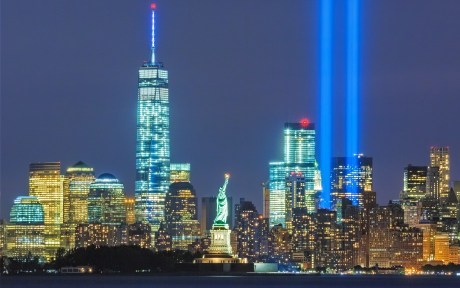
As we mourn the tragic losses of the 9/11 attacks twenty years on, we thought it would be appropriate to re-examine the remarkable resilience New York City’s economy has shown over the years—a resilience that is once again being tested by the ongoing COVID-19 pandemic. In this Liberty Street Economics post, we look at how Lower Manhattan, in particular, has changed since that tragedy on a number of dimensions, and use that as a framework to think about how the city might change as a result of the COVID pandemic.
Living and Working in Lower Manhattan
First let’s briefly revisit some of the metrics we used in an earlier blog post from 2016 to gauge the city’s recovery on the fifteenth anniversary of 9/11. In terms of residents, Lower Manhattan (which here comprises the area roughly south of Chambers Street and by postal address these zip codes: 10004, 10005, 10006, 10007, 10038, 10280, and 10282), saw its population fall more than 10 percent following the attack—in large part because so many apartment buildings were badly damaged and uninhabitable, at least temporarily. By 2005, as the affected buildings had come back on line and life had returned to normal, the population had rebounded to a new high. And as of 2016, when we published the earlier blog post, the population had skyrocketed by about 50 percent compared to pre-9/11, as scores of new apartment buildings were developed and more office buildings were converted to residential use.
To gauge what has happened since, we return to our Consumer Credit Panel, which is based on anonymized Equifax credit reports, to get refreshed population estimates. We find that this strong uptrend in population continued between 2016 and early 2020, with a further 14 percent increase in the residential population in Lower Manhattan’s zip codes. Since the onset of the pandemic in March 2020, Lower Manhattan’s population has declined by 5.0 percent, but as of July 2021, it was still a striking 73 percent higher than in June 2001. Lower Manhattan has evolved into a vibrant residential neighborhood, thanks in part to substantial federal, state, and city investments in the post 9/11 years.
In terms of employment, the rebound was far weaker, constrained by the slow construction of the replacement office towers. At the time of our earlier blog post, based on available data through 2014, total employment in the financial district (FiDi) was still well below 9/11 levels. However, the subsequent completion of One World Trade Center and the other buildings in the World Trade Center complex, the Fulton Transit Center, Oculus, and Brookfield Place has changed that. Lower Manhattan employment had reversed roughly three quarters of the net job loss from 9/11 by 2018, and it was essentially steady through early 2020. However, the industry mix had changed fairly dramatically: tabulations by the Alliance for Downtown New York indicate that employment in finance/insurance—traditionally Lower Manhattan’s key industry—accounted for just 30 percent of private-sector employment, down from 55 percent in 2001 (before the attacks), as employment in that sector fell by roughly 60,000, or almost half. Meanwhile, almost all other industry sectors saw substantial job gains, most notably accommodation and food services (that is, restaurants and hotels) where employment roughly doubled.
Tourism
Underlying much of this industry diversification across FiDi was a sustained surge in tourism—which had been hit hard by 9/11—starting around 2005. That, accompanied by the rapid population growth, produced a boom in restaurants and hotels. According to tabulations by the Alliance for Downtown New York, there were nearly 2,500 hotel rooms in Lower Manhattan in mid-2001, but that fell to 1,631 after the loss of the Marriott World Trade Center. But the growth in tourism to New York City as well as to Lower Manhattan itself was reflected in a surge in hotel development. By the start of 2020, there were 7,642 hotel rooms in Lower Manhattan—a near quintupling of hotel capacity in the neighborhood. While there have been some hotel closures due to the pandemic, there remain more than 7,000 hotel rooms in Lower Manhattan. The restaurant and bar industry responded similarly to the increase in foot traffic with almost as impressive growth. Together, the accommodation and food industries saw a doubling in employment between 2001 and early 2020. And even in 2021, there were nearly 50 percent more eating and drinking establishments compared to 2001.
Infrastructure and Real Estate
With the damage and destruction to not only buildings but also to transit and other infrastructure, one thing that local policymakers resolved to do early on was to put a great deal of thought and resources into rebuilding better. With that reserve came a remarkable volume of federal aid for infrastructure investment and recovery, for example, contributing to the Fulton Transit Center (in 2014) and the Oculus (in 2014). There were setbacks along the way—most notably, perhaps, Superstorm Sandy in 2012, which flooded much of Lower Manhattan, including the South Ferry subway terminal. Nevertheless, as of today, Lower Manhattan is easily accessible by numerous subway lines, PATH service, multiple ferries, and dedicated bike lanes. As New York City continues its gradual recovery from the depths of the pandemic, these infrastructure investments continue to make Lower Manhattan an exceptionally convenient location for both working and living.
Yet, while there has been massive residential development, office development has been slow. One surprising outcome of the 9/11 attacks was the effect on Lower Manhattan’s office market. In the initial days, some industry experts had feared that the physical destruction of office space would create a dire shortage and cause vacancy rates to plummet and office rents to rise. On the contrary, there was a great deal of “shadow space” in the office market—space that was not offered for rent or sublease but was, in fact, empty and available. This phenomenon was largely a function of the “dotcom” boom and subsequent bust. This reflected the office market not only in Lower Manhattan, but also in Midtown Manhattan, nearby New Jersey (the “gold coast”), and the outer boroughs. This slump in office demand likely contributed to the time it took to develop all the office space that now exists in FiDi. However, some academics’ predictions of a longer-term demise of central cities, most notably Manhattan, turned out to be way off the mark as well.
Even so, while Manhattan overall has more office space today than right before the 9/11 attack, Lower Manhattan still has much less: 124M square feet now versus 141M before. This is due, in part, to structural economic shifts rooted in new technologies—demand for subprime-quality office space diminished as back-office operations no longer had to be located in one of the priciest office markets in the nation and businesses vacated large swathes of space. Meanwhile, increasingly strong demand for residential space and tax incentives encouraged residential conversion projects. While newer, high quality office buildings have been developed, a great deal of older office space has been converted to residential use. Still, Lower Manhattan retains more office space than the central business district of any other U.S. city, according to CoStar.
These shifts are reflected in the outsized increases in Lower Manhattan’s housing stock. Pre-9/11, there were approximately 13,000 residential units, but solid yearly growth through new construction and conversions of office space has nearly tripled Lower Manhattan’s residential inventory to approximately 33,000 units.
Conclusion
In retrospect, the recovery from the 9/11 attacks has provided some useful lessons. First and foremost is the resilience of the economy—really, businesses, policymakers, and people generally—to adapt and respond to unexpected disasters. Second is that places become major economic hubs for a wide variety of reasons and retain a great deal of inertia—that is, they tend to hold on to their advantages through major setbacks. Lower Manhattan today retains a large volume of office space, though less than before 9/11. Still, the post-9/11 tax incentives drew in a large residential population, and tourism grew substantially through 2019. Although Lower Manhattan, like many urban neighborhoods, struggles to rebound after emptying out due to the pandemic, the neighborhood has flourished since its greatest test, despite an outright reduction in office space and office workers.

Jason Bram is a research officer in the Federal Reserve Bank of New York’s Research and Statistics Group.

Joelle Scally is a senior data strategist in the Bank’s Research and Statistics Group.
Disclaimer
The views expressed in this post are those of the authors and do not necessarily reflect the position of the Federal Reserve Bank of New York or the Federal Reserve System. Any errors or omissions are the responsibility of the authors.










 RSS Feed
RSS Feed Follow Liberty Street Economics
Follow Liberty Street Economics